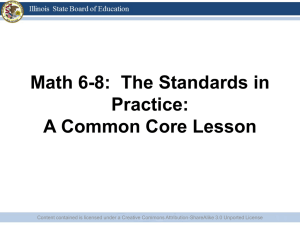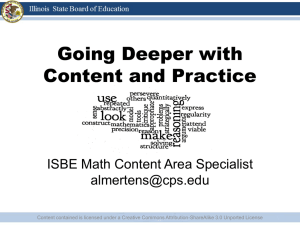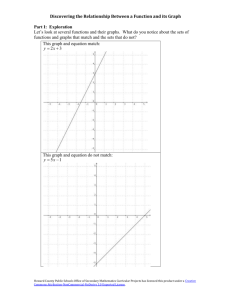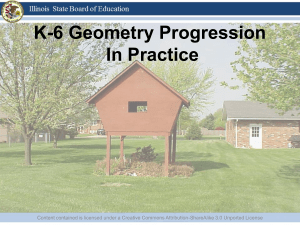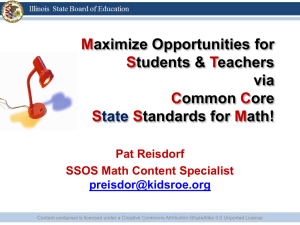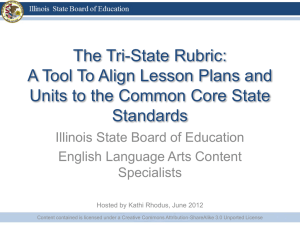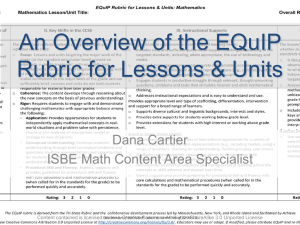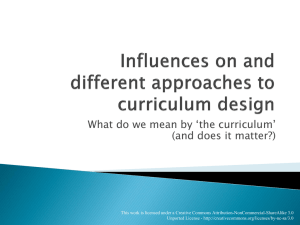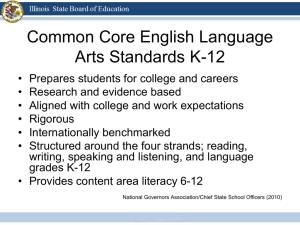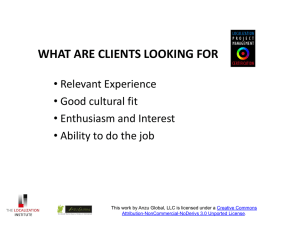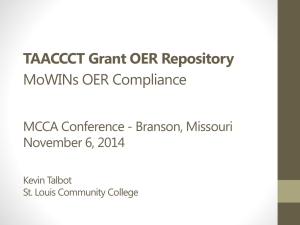Ongoing Assessment - Illinois State Board of Education
advertisement
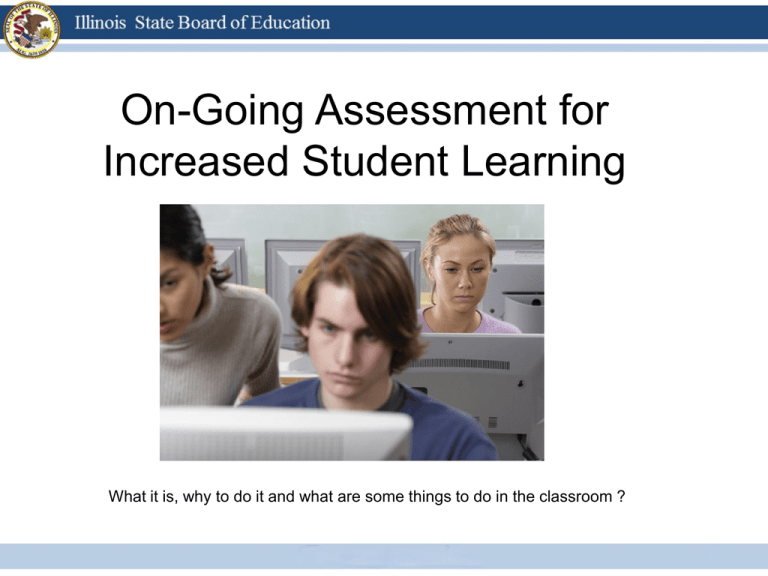
On-Going Assessment for Increased Student Learning What it is, why to do it and what are some things to do in the classroom ? Presenter Sue Mainville Data and Assessment Specialist-Area 2 Here We Go! • What is meant by on-going/assessment for learning? • Why use the practice? • How can I use on-going/assessment for learning to enhance what I currently do? • simple ways to begin a classroom transition Content contained is licensed under a Creative Commons Attribution-ShareAlike 3.0 Unported License Ongoing Assessment is like a GPS because… Formative Assessment FOR Learning Content contained is licensed under a Creative Commons Attribution-ShareAlike 3.0 Unported License Ongoing Assessment is NOT • a test • an interim test • frequent summative assessments It is NOT formative unless something happens as a result of the evidence. Content contained is licensed under a Creative Commons Attribution-ShareAlike 3.0 Unported License Ongoing assessment is… • • • • to question rather than explain. to listen rather than talk. to center on student learning. to assess for learning. The instruction must change as a result of the assessment for it to be formative. Content contained is licensed under a Creative Commons Attribution-ShareAlike 3.0 Unported License Why Ongoing Assessment? “Research reported shows conclusively that formative assessment does improve learning.” - Assessment in Education 1998 “Reports conclude that formative assessment will improve student learning, even when not done ‘perfectly’.” - James Popham, Ed.D (2011) Content contained is licensed under a Creative Commons Attribution-ShareAlike 3.0 Unported License Why Ongoing Assessment? • It supports the learning process by serving as practice for students. • It checks for understanding along the way and provides the teacher and student with feedback so the student can improve. • It inspires the student to do better the next time. Content contained is licensed under a Creative Commons Attribution-ShareAlike 3.0 Unported License Why Ongoing Assessment? • It gives students responsibility for their learning. • Moves learning forward • It targets individual student needs • It gives on-going feedback • It works! Content contained is licensed under a Creative Commons Attribution-ShareAlike 3.0 Unported License Visible Learning: A Synthesis of over 800 meta analyses related to achievement by John Hattie Content contained is licensed under a Creative Commons Attribution-ShareAlike 3.0 Unported License Brain Break http://www.youtube.com/watch?v= Zx9a7sxVeNM Content contained is licensed under a Creative Commons Attribution-ShareAlike 3.0 Unported License Assessment FOR Learning Curricular components, classroom quizzes and activities • • • • • Includes instructionally embedded activities Usually teacher/locally developed Yields rich diagnostic information Informs and focuses instructional decisions Occurs when we are teaching the components Content contained is licensed under a Creative Commons Attribution-ShareAlike 3.0 Unported License Things to Consider • Start small • Teach students new class structure and climate • Ask fewer, better questions • Allow students freedom to discuss • Explain to students their responsibility in learning Content contained is licensed under a Creative Commons Attribution-ShareAlike 3.0 Unported License Ways to assess your students in the learning process • • • • • • • Foldable and Graphic Organizers Read, write, pair, share 3-2-1 3 Facts and a Fib Vote with your feet Exit Slips ELA strategies and assessments Increasing the Rigor in Multiple Choice Questions George collected 489 rocks for his science project. Matthew collected100 fewer than George. How many rocks did Matthew collect? a.389 b.479 c.589 d.379 Defend your answer and then select another answer and explain why it is incorrect. Content contained is licensed under a Creative Commons Attribution-ShareAlike 3.0 Unported License Next Steps • Once you assess your students, take action based on those results. • reteach (usually in a different way based on their learning style) • peer tutoring • small group • one-on-one Content contained is licensed under a Creative Commons Attribution-ShareAlike 3.0 Unported License Data Management • Clip boards • Standards-based Grade Book • Writer’s Journals with Conference Sheets Resources Black, Paul & Wiliam, D.(2001). “Inside the Black Box -Raising Standards Through Classroom Assessment”, King’s College London School of Education. Balanced Assessment: The Key to Accountability and Improved Student Learning, NEA (2003). http://www.nea.org/accountability/nearesources-accountability.html Hattie, John,(2011). Visible Learning: A Synthesis of over 800 meta analyses related to achievement. “(In)formative Assessments,” Harvard Education Letter, 2006. Partnership for the Assessment of Readiness for College and Careerswww.parcconline.org Popham, James Ed. D, (2011). Reeves, Doug, (2012). “The Leadership and Learning Center, Visible Learning: Applying John Hattie’s Research to Maximize Learning in Your School” (webinar), 1/23/12. Illinois State Board of Education – www.isbe.state.il.us Show Me the Strategies - http://fcstn.net/show%20me%20the%20strategies.htm Content contained is licensed under a Creative Commons Attribution-ShareAlike 3.0 Unported License Contact Information Agurann H. Bates ISBE-Thompson Building -Chicago, IL abates@isbe.net Dr. Brenda M. Arrington – Area 1a ROE/Professional Development Alliance-Joliet , IL barrington@pdaonline.org Tim Farquer – Areas 3&4 Two Rivers Professional Development Center –Peoria, IL timfarquer@gmail.com Sue Mainville – Area 2 K.I.D.S. - Loves Park, IL smainvil@kidsroe.org Content contained is licensed under a Creative Commons Attribution-ShareAlike 3.0 Unported License

